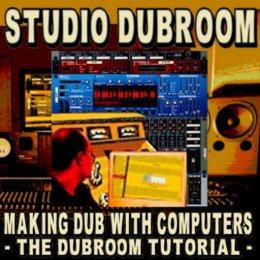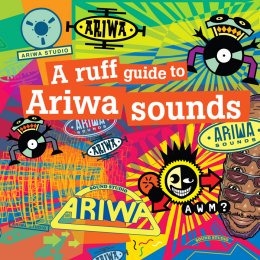MAKING DUB WITH COMPUTERS CHAPTERS
22 AND 23: CONCLUDING MIDI, TALKING SOFTWARE REQUIREMENTS
STUDIO DUBROOM DOWNLOAD

WWW, September 8 2014 - A Couple of days
ago, I published chapter 21 of my Computer Dub Tutorial and today I offer you
two new chapters, one of which you can read in it's fullness on this page. We're
concluding the MIDI part, the phase wherein we make an instrumental Reggae track
because if you don't have that, well, you can't make (a) Dub. We're taking a
look at what kind of software you need, and a little bit at hardware too.
Since you are reading this, you're probably
visiting one of the Dubroom's blogs or the forum. That could mean you are
waiting for chapters to be added. I'm sure you don't mind me writing a few
personal notes before I paste chapter 22 and a part of 23 into this post. The
fact I receive a lot of positive feedback from producers all over the world
lately makes me humble once more, as I realize how much more I should add, and
-Jah Willing- shall add chapters. I do take this serious, even though I am aware
that the things I know in themselves are in it's turn a fraction of what people
like Mad Professor know.
One good thing about this tutorial, is the fact
that it is located on the Dubroom website. I only post fragments of chapters
because the tutorial really needs to be studied from the pages. As I'm working
on new chapters, I equally look at the older ones and I plan to add a lot of
extra information as time progresses. I also now have the possibility to record
video and audio from my computer screen and sound card, which I am sure will be
most helpful when we will finally arrive there, where it's all about: the DUB.
All that said, here's the latest additions to
the tutorial:
PART 22: MIDI (12) - THAT'S WHY MIDI
In the previous chapter we added the last
instruments to our instrumental Reggae track. A track, we created with the use
of the MIDI protocol. En passant we've been taking a close look just how
a Reggae rhythm is constructed, how you can find a good bass line with your
chords or vice versa, and a whole heap more. We're into the 22nd chapter, and
actually all we have been doing is laying a ground work for future Dub projects.
All we have been doing is creating an instrumental Reggae track with total
disregard of any sound balance, and so the track sounds awful. That's what we're
going to be working on in the next few chapters.
When I started to write this tutorial I was
dealing with like the first generation Audio cards that needed quite a specific
set-up. I remember that I had to physically open my computer and change things
so that two sound cards could work on one computer, even. In the same time, the
way I made my Dub was totally different in these times. It would take me over 5
minutes to create just one echo.
When I discovered Propellerhead Reason, my
working method completely changed. What did not change was the fact that I made
my instrumental Reggae tracks with midi (and a few audio loops). In spite of all
the developments, what has not changed in making Dub with (or without) a
computer is the fact that you'll need something to Dub and usually that would be
an instrumental Reggae track, or a multi track recording of a Reggae track with,
let's say, vocals on them.
So, in a way, it's very good that it took such
a long time before we're actually in this part of the tutorial. I don't have to
introduce you to a working method that requires more than patience, self control
and what have you.
We will still be using the MIDI protocol
throughout the entire tutorial. It can't be different, because what we have been
doing by creating the music is the very same thing what we will be doing when
we're actually in the Dub phase. After all, because of Midi we can give
instructions to not just a keyboard, but a mixing board, effect devices and all
the things we'll be using. Because of MIDI we can make Dub with computers in the
first place.
However, it is time to make some closing
remarks about this segment of the tutorial. We have been creating an
instrumental Reggae track, even though it's not the next Reggae world hit. You
now know why MIDI is a very important part in the creation of music, any music.
You know now how to make your own instrumental Reggae track.
We now have to use this track and turn it into
a Dub track, something we'll be doing in the next chapters.
PART 23: CREATING A SET UP (1): SOFTWARE
REQUIREMENTS
Now that we have our instrumental, you could say
that we have a multi-track recording. We have several different instruments all
playing their musical part over their own channel on the mixing board. By
putting one instrument louder than the other, you create a mix. By adding
effects like delay and reverb to the mixing board, you're ready to make a
Dub.
In short, that is.
To create the instrumental track we've
programmed in the last chapter, I have been using Reason 3.04. Now, in September
2014, this is a rather dated version of the superb software by Propellerhead.
Add to that, there is software called Ableton which I have started to look at in
this year as well but about which I know close to nothing. Add to that the
countless other titles in music software, and the -often totally irrelevant-
question which software to use, and you have a problem when you're writing how
to create Dub with computers.
The software.
Let me describe just what I'll be using Reason
3.04 for in the next chapters, in more general terms. This will not just enable
you to go along in this tutorial as you make a set up in your favorite software
title, it will enable you to obtain the right software in case you are wondering
just what to use. Since the version of Reason I use is not the latest, I suspect
that there are a lot of titles that will give you the features required for this
tutorial. Probably even free titles. When you know of a few, let
me know and I'll add them to this tutorial somewhere.
In short, what you need is a title that enables
you to simulate everything you would do when you would have a physical studio
with hardware. You want to have a mixing board with instruments and effects
devices attached, at least four aux-outputs, and you want to be able to change
any setting on any device at anytime. This is called "automation".
Here's a check-list:
CLICK
HERE TO READ, WATCH AND LISTEN FURTHER TO CHAPTER 23


